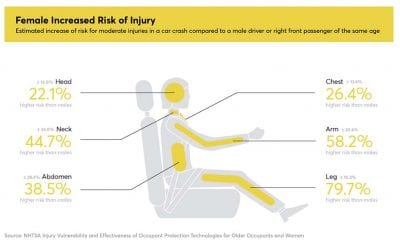The FAA’s emergency evacuation tests for aircraft certification need to reflect real-world conditions.

Just before 5:40 pm on Tuesday, June 21, the plane touched down. Within moments, the landing gear failed, sending the jet sliding off Runway Nine on its belly. With fuel spilling from its starboard wing, seconds later the wing became engulfed in fire. The smoke from the fire could be seen for miles.
Many flight 203 passengers slowed the plane’s evacuation, making it unnecessarily dangerous, by dragging their carry-on luggage with them when evacuating.

It’s been reported that seven passengers were injured in the crash, none seriously, including pregnant women. Three of the injured passengers were taken to a nearby hospital but later released, according to reports.
I’ve personally been on a flight that required emergency evacuation.
I’ve been on a flight that had to be evacuated. I was flying from Pittsburgh to Philadelphia on a cold December evening. The plane was nearing takeoff velocity when we heard the brakes screech, the jet engines change pitch, and felt the aircraft shudder as we rapidly slowed. The pilot had aborted the takeoff. It turned out that the cockpit went black; no lights or instruments. When the plane finally stopped, the nose gear was in the snow, past the end of the runway, but held. From the windows, we could see smoke billowing from underneath the plane. The brakes were fried.
When we came to a halt, only the emergency cabin lights were illuminated. Among the passengers there was panic, fear, hysteria, screaming, and crying. Most of the children were inconsolable.
Passengers’ bad behavior slowed everyone down during my Pittsburgh emergency evacuation.
While some passengers immediately headed for the exits following the crew’s instructions, many others scrounged their bags from the floor where they had flown out from overhead bins during the aborted takeoff or grabbed bags still there. The aisle became blocked and some passengers brushed others aside by aggressively pushing other passengers. The passengers who grabbed their bags doubled our exit time, potentially endangering themselves and other passengers.
In 2007, the Airbus A-380 ran its emergency evacuation test for certification of the giant aircraft. They had 90 seconds to complete the evacuation or they would have failed the test. A failure could have prevented the plane from going into service for months, perhaps longer. They passed. Successfully, the plane was evacuated in 78 seconds.
The A-380 evacuation test was fiction because its conditions were nothing like what happens in a real-world evacuation.
Remembering my Pittsburgh flight, when I wrote about the A-380 evacuation test I noted while watching the video of it that it had nothing to do with a real-world emergency aircraft evacuation. It seemed then and still does today that the test was an emergency evacuation fiction and proved nothing about passengers’ ability to evacuate from an A-380 in a real crash.
In the A-380 test evacuation, there was no panic. Everyone followed the crew’s instructions. There was no misbehavior, no pushing, no grabbing luggage, nothing but a quick, orderly exit from the plane. Not a single test passenger hesitated going down the chutes, even from the height of the second deck. The test passengers looked liked well drilled soldiers following orders. On the other hand, watching the videos of the MD-82 crash in Miami, I saw my Pittsburgh experience. The passengers exhibited the same fears along with the same foolish and irrational behavior.
Major FAA evacuation test requirements are insufficient.
Let’s look at the criteria of the FAA’s full-scale emergency evacuation test and determine why the test doesn’t match real world crash reality.
For their emergency evacuation test, the FAA has the following major requirements:
- Planes must be at full seating capacity, including crew members, and be fully evacuated in 90 seconds or less.
- The participants in the test must include specific percentages of adults, seniors (men and women) and children, but it’s permitted to run the tests without children due to child labor laws.
- Among passengers, no employee of the aircraft company or airline may be seated next to an exit.
- No practice evacuation is permitted.
- No more than half the exits may be opened and used for the test.
- The test must be run in darkness or simulated darkness.
The criteria may look reasonable until examined with a critical eye. Some of the criteria can be manipulated to circumvent the criteria’s intent. Much of the criteria don’t resemble the conditions in a real-world accident/crash.
Let’s get into it!
The age distribution of test passengers in the evacuation test doesn’t reasonably reflect the ages of passengers on actual flights.
The test plane is required to be full of passengers, but let’s look at who’s in the seats. There is a specific distribution of men and women aged 12–60 and over 60 in the test. The FAA only requires five percent of the passengers to be over 60. Based on statistical data, that percentage is at least half of what’s needed of passengers who are likely the slowest physically during the evacuation. The FAA allows the test to go on without children. Experience has shown me that in an emergency, children are likely to be extremely frightened and uncooperative. They can’t be left out of the tests.
Merely not permitting aircraft and airline employees to be test passengers seated next to exits is absurd. No aircraft, airline, or contractor employee should be permitted to be test passengers at all. If you look at the A-380 evacuation test, you see passengers who follow directions precisely, don’t argue with the crew, are calm, don’t push or shove, and don’t grab any luggage and other belongings on their way out. Passengers in real accidents/crashes are nothing like that. Real-world evacuations aren’t like a well-oiled drill. They’re chaos.
The FAA doesn’t simulate real-world conditions during evacuation tests.
The FAA test doesn’t simulate real-world conditions. They should have an evacuation test with smoke in the plane making everyone’s eyes tear and making it difficult to see where you’re going to get to an exit and out of the plane.
I seriously question the validity of the FAA’s aircraft evacuation test. Evacuation certification tests should mimic real world conditions to see if the plane can be safely evacuated in case of a real accident/crash. If the tests were more life-like, the evaluation of them would be far more helpful to the FAA and airlines in developing significantly better evacuation procedures that would take into account accident/crash chaos, senior citizens who move slowly and children who are scared to death and uncooperative.

I call upon the FAA to thoroughly reexamine their aircraft emergency evacuation test and make it reflect what actually goes on in a plane when an accident/crash occurs. Let’s stop pretending and get much more serious about passenger safety.
(Image: American Airlines A319 landing at Philadelphia International Airport. Copyright © 2018 NSL Photography. All Rights Reserved.)
READ ALSO:
Airline customer service commitments — are they worthless?
Flying domestically after May 3, 2023? You’ll need a REAL ID 2023!
After many years working in corporate America as a chemical engineer, executive and eventually CFO of a multinational manufacturer, Ned founded a tech consulting company and later restarted NSL Photography, his photography business. Before entering the corporate world, Ned worked as a Public Health Engineer for the Philadelphia Department of Public Health. As a well known corporate, travel and wildlife photographer, Ned travels the world writing about travel and photography, as well as running photography workshops, seminars and photowalks. Visit Ned’s Photography Blog and Galleries.



